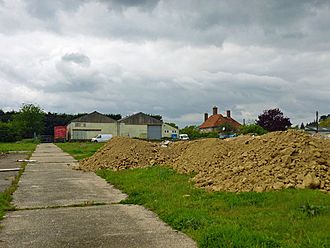Fernhurst Research Station facts for kids
Quick facts for kids Fernhurst Research Station |
|
|---|---|

Part of the former research station
|
|
| Former names | Fernhurst Research Centre |
| Alternative names | ICI Fernhurst, Plant Protection Fernhurst |
| General information | |
| Type | Chemical Research Centre |
| Address | Fernhurst, West Sussex, GU27 3ER |
| Coordinates | 51°02′N 0°43′W / 51.03°N 0.72°W |
| Elevation | 80 m (262 ft) |
| Current tenants | Vacated |
| Completed | 1945 |
| Client | ICI |
| Owner | ICI Plant Protection |
| Landlord | ICI Plant Protection |
The Fernhurst Research Station was a special place in West Sussex, England. It was a research center that focused on protecting crops, especially fruits. The company ICI mainly ran it.
The station was located near the village of Fernhurst. You could find it east of the A286 road. It was about a mile south of Fernhurst village.
Contents
History of Fernhurst Research
Early Days and Research Focus
In 1945, a company called Plant Protection Limited moved to this site. They opened a research center there. This center was built on land that used to belong to Sir Felix Schuster.
The main goal of the research center was to study how to control pests and diseases in plants. They focused on crops grown for food, like fruits. Besides being an office area, the station also had a large orchard. This orchard was about 60 acres in size. It included 9 acres of plum trees and 26 acres of dessert apple trees.
Important Visitors and Conferences
The Fernhurst Research Station became quite well-known. In June 1951, scientists from 39 different countries came together there. They held a big international meeting to talk about how to deal with food shortages around the world.
A few years later, on May 10, 1955, a very important person visited the site. It was Prince Philip, Duke of Edinburgh, a member of the British Royal Family. Another international meeting for scientists took place at the station in June 1956.
Becoming Part of ICI
In 1958, Plant Protection Limited became a full part of Imperial Chemical Industries, or ICI. It was then known as ICI Plant Protection Division. The Fernhurst site became the main international office for this division. This continued until the 1990s.
In 1986, a new international meeting center was opened at the site. The Prime Minister at the time, Margaret Thatcher, officially opened it. In 1989, a new group called ICI Public Health also started working from the Fernhurst site.
Achievements and Awards
Throughout its time, the station grew many different crops. They grew them both indoors and outdoors for research. They also developed new and better ways to grow crops and apply treatments. They even had a film unit to record their findings!
In April 1990, the Fernhurst site received a special honor. They won a Queen's Award for Technological Achievement. This award was for their excellent work on chemicals that kill weeds (herbicides), fungi (fungicides), and pests (pesticides).
Changes and Closure
In 1994, a company called Zeneca took over the site. Later, it became the headquarters for Syngenta Europe Ltd. However, Syngenta left the site in December 2001.
After Syngenta left, the site stopped being a research station. Most of the office buildings became empty. At its busiest time, about 700 people worked at the Fernhurst Research Station.
Future of the Site
Parts of the old research station are now being redeveloped. In 2020 and 2021, plans were approved to build new homes on the Highfield part of the site. This project is being managed by the South Downs National Park Authority.

